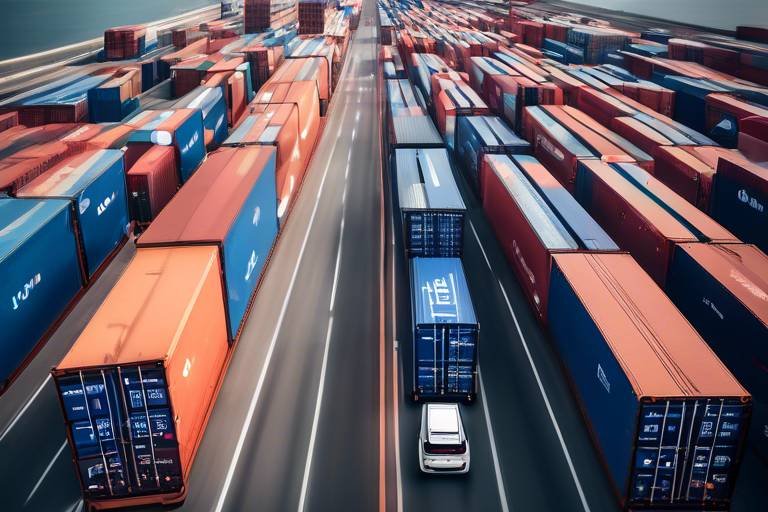AI in Logistics: Driving Efficiency in Shipping
In today's fast-paced world, the logistics and shipping industry is undergoing a remarkable transformation, largely fueled by the advent of artificial intelligence (AI). Imagine a world where shipments arrive not just on time, but with pinpoint accuracy, where inventory levels are optimized to avoid both shortages and surpluses. This is not just a dream; it's the reality that AI is creating in logistics. With its ability to analyze vast amounts of data and make real-time decisions, AI is driving unprecedented efficiency in shipping processes.
The integration of AI into logistics is akin to having a supercharged engine in a vehicle; it enhances every aspect of the journey. From demand forecasting to last-mile delivery, AI technologies are reshaping how businesses operate, ultimately leading to reduced costs and improved service levels. This article will delve into the various ways AI is revolutionizing logistics, illustrating its profound impact on supply chain management and operational efficiency.
As we explore the role of AI in logistics, it's essential to recognize how it streamlines supply chain processes. By leveraging AI technologies, businesses can enhance their decision-making capabilities, resulting in more efficient operations. For example, AI can analyze historical sales data to predict future demand, allowing companies to align their inventory with market needs. This not only reduces excess stock but also ensures that popular items are readily available when customers want them.
Furthermore, AI's predictive analytics capabilities are a game-changer for demand forecasting. By anticipating customer behavior, businesses can fine-tune their supply chains to meet actual demand rather than relying on gut feelings or outdated data. The result? A leaner, more responsive operation that can adapt to market fluctuations with ease. Think of it as having a crystal ball that helps you see what your customers will want next, allowing you to stay one step ahead.
In summary, the transformative impact of AI in logistics is undeniable. It is not just about technology; it's about creating a more efficient, responsive, and customer-centric shipping process. As we move forward, embracing AI will be crucial for businesses looking to thrive in a competitive landscape.
AI technologies streamline supply chain processes by improving demand forecasting, inventory management, and logistics planning, leading to enhanced decision-making and operational efficiency.
- What is the primary benefit of AI in logistics? AI enhances operational efficiency, reduces costs, and improves service levels by optimizing various logistics processes.
- How does AI improve demand forecasting? By utilizing predictive analytics, AI anticipates customer demand more accurately, helping businesses align their supply with market needs.
- What role do autonomous vehicles play in logistics? Autonomous vehicles increase efficiency, reduce labor costs, and enhance safety in shipping operations.
- Are there challenges to adopting AI in logistics? Yes, businesses face challenges such as data privacy concerns, integration issues, and the need for employee training.

The Role of AI in Supply Chain Management
In today's fast-paced world, where consumer expectations are higher than ever, artificial intelligence (AI) is stepping up to the plate in supply chain management. Imagine a world where companies can predict demand with pinpoint accuracy, manage inventory seamlessly, and plan logistics like a chess master. That's the power of AI! By leveraging advanced algorithms and data analytics, businesses can transform their supply chain processes into well-oiled machines, enhancing both efficiency and profitability.
One of the most significant ways AI contributes to supply chain management is through improved demand forecasting. Traditional methods often rely on historical data and gut feelings, which can lead to overstock or stockouts. However, AI takes this a step further by utilizing predictive analytics to analyze vast amounts of data, including market trends, consumer behavior, and even social media sentiment. This enables companies to anticipate customer demand more accurately, ensuring they have the right products at the right time, thus reducing excess inventory and improving service levels.
But that’s just the tip of the iceberg! AI also plays a crucial role in inventory management. With the help of machine learning algorithms, businesses can analyze historical data to optimize their inventory levels. This means they can maintain the perfect stock quantities, minimizing holding costs while also reducing the chances of stockouts. Just picture a retail store that never runs out of your favorite products because they have a smart system in place predicting your needs!
Moreover, the integration of real-time data from various sources is revolutionizing how businesses manage their inventory. AI systems can adjust inventory recommendations dynamically based on real-time sales data and market fluctuations. This responsiveness is crucial in today’s market, where consumer preferences can change overnight. Imagine being able to pivot your stock in response to a viral trend—AI makes that possible!
Another exciting development is the rise of automated replenishment systems. These systems, powered by AI, can automatically place orders based on predictive analytics and real-time sales data. This not only saves time but also ensures that businesses maintain optimal inventory levels without the constant manual oversight. Think of it as having a personal assistant who knows exactly when to reorder supplies without you having to lift a finger.
In summary, the role of AI in supply chain management is transformative. From enhancing demand forecasting to optimizing inventory levels and automating replenishment, AI is paving the way for a more efficient, cost-effective, and responsive supply chain. As businesses continue to embrace these technologies, the benefits will only grow, setting a new standard for efficiency and customer satisfaction in the logistics industry.
- How does AI improve demand forecasting? AI improves demand forecasting by analyzing large datasets to identify trends and predict future consumer behavior.
- What are the benefits of automated replenishment systems? Automated replenishment systems reduce manual oversight, ensure optimal inventory levels, and save time for businesses.
- Can AI help reduce supply chain costs? Yes, by optimizing inventory levels and improving demand forecasting, AI can significantly reduce holding costs and stockouts.

Predictive Analytics for Demand Forecasting
Imagine walking into a store and finding exactly what you need, right when you need it. That’s the magic of predictive analytics in demand forecasting! This powerful tool helps businesses anticipate customer needs with remarkable accuracy, ultimately transforming the way they manage inventory and supply chains. By leveraging vast amounts of data, predictive analytics enables companies to make informed decisions that align supply with actual market demand, reducing the risk of overstocking or running out of popular products.
At its core, predictive analytics uses historical data and statistical algorithms to identify patterns and trends. This information is then used to forecast future demand. For instance, a clothing retailer might analyze past sales data during different seasons to predict which items will be in high demand next spring. The result? They can stock up on those trendy items before the rush, ensuring they don’t miss out on sales opportunities.
One of the most significant advantages of utilizing predictive analytics is its ability to minimize excess inventory. Businesses often find themselves stuck with products that don’t sell, tying up valuable resources. By accurately forecasting demand, companies can maintain optimal inventory levels, leading to cost savings and improved cash flow. For example, a grocery store can use predictive analytics to anticipate the demand for seasonal items like holiday turkeys, ensuring they have enough stock without over-purchasing.
Moreover, predictive analytics enhances service levels by allowing businesses to respond quickly to changes in consumer behavior. With real-time data integration, companies can adjust their inventory strategies on the fly. For instance, if a sudden trend emerges on social media, a retailer can quickly ramp up production or adjust their orders to meet the new demand. This agility not only satisfies customers but also strengthens the overall supply chain.
To illustrate the impact of predictive analytics, consider the following table that outlines the benefits:
| Benefit | Description |
|---|---|
| Improved Accuracy | Enhances forecasting precision by analyzing historical trends. |
| Cost Reduction | Minimizes excess inventory and reduces holding costs. |
| Increased Responsiveness | Allows businesses to adapt quickly to market changes. |
| Better Customer Satisfaction | Ensures products are available when customers want them. |
In conclusion, predictive analytics serves as a crucial component in the logistics and shipping industry, enabling businesses to forecast demand accurately and manage their inventory effectively. By embracing this technology, companies can not only enhance their operational efficiency but also create a more satisfying experience for their customers. In a world where consumer preferences can change in the blink of an eye, being able to anticipate demand is not just a competitive advantage—it's a necessity.
- What is predictive analytics?
Predictive analytics involves using historical data and statistical algorithms to forecast future trends and consumer behavior. - How does predictive analytics benefit businesses?
It helps businesses reduce excess inventory, improve cash flow, and enhance customer satisfaction by aligning supply with actual demand. - Can predictive analytics be integrated with existing systems?
Yes, many predictive analytics tools are designed to integrate seamlessly with existing inventory and supply chain management systems. - What types of data are used in predictive analytics?
Data from sales history, market trends, customer behavior, and external factors like seasonality are commonly used.

Machine Learning Algorithms in Inventory Management
When it comes to inventory management, machine learning algorithms are nothing short of a game changer. These sophisticated algorithms are designed to analyze vast amounts of historical data, which allows businesses to make informed decisions about their stock levels. Imagine having a crystal ball that not only tells you what products will sell but also predicts how much you need to keep on hand. This is the magic of machine learning!
By leveraging machine learning, companies can optimize their inventory levels in several ways. For starters, these algorithms can identify patterns in purchasing behavior that might not be immediately obvious. For instance, they can analyze seasonal trends, promotional impacts, and even shifts in consumer preferences. This kind of insight enables businesses to maintain the right stock quantities while minimizing holding costs and reducing the risk of stockouts.
One of the most significant advantages of using machine learning in inventory management is the ability to create dynamic models that adapt to real-time data. This means that as customer preferences change or unexpected events occur—like a sudden spike in demand due to a viral trend—businesses can quickly adjust their inventory strategies. To illustrate, let’s consider a retail company that sells outdoor gear. If a popular hiking trail suddenly goes viral, machine learning algorithms can help the company forecast increased demand for hiking equipment, ensuring they have enough stock on hand to meet customer needs.
Furthermore, machine learning algorithms can be integrated into automated replenishment systems, which further enhances efficiency. These systems can automatically place orders based on predictive analytics and real-time sales data, reducing the burden on inventory managers and allowing them to focus on more strategic tasks. Think of it as having an intelligent assistant that never sleeps and always knows when to reorder stock!
The benefits of machine learning in inventory management extend beyond just maintaining optimal stock levels. They also contribute to better cash flow management by reducing excess inventory and freeing up capital that can be used elsewhere in the business. In a nutshell, machine learning not only helps businesses save money but also empowers them to respond to market demands with agility and precision.
However, it's important to note that while the advantages are compelling, implementing machine learning algorithms requires a solid foundation of data quality and infrastructure. Companies must ensure that their data is accurate and comprehensive, as poor data can lead to flawed predictions. Additionally, organizations may need to invest in training for their employees to effectively utilize these advanced technologies.
In conclusion, the integration of machine learning algorithms into inventory management is transforming how businesses operate. By enhancing decision-making and operational efficiency, these technologies are paving the way for a smarter, more responsive supply chain. As we look to the future, it's clear that the companies that embrace these innovations will have a significant competitive edge in the ever-evolving marketplace.
- What are machine learning algorithms?
Machine learning algorithms are computer programs that analyze data, learn from it, and make predictions or decisions without human intervention. - How can machine learning improve inventory management?
Machine learning can enhance inventory management by predicting demand, optimizing stock levels, and automating replenishment processes. - What challenges do companies face when implementing machine learning?
Challenges include ensuring data quality, integrating with existing systems, and providing adequate training for employees. - Is machine learning suitable for all businesses?
While machine learning can benefit many businesses, its effectiveness depends on the quality of data and the specific needs of the organization.

Real-Time Data Integration
In the fast-paced world of logistics, has emerged as a game-changer. Imagine a bustling warehouse where every movement, every item, and every order is tracked in real-time. This is not just a dream—it's the reality that AI technologies are bringing to the logistics industry. By integrating data from various sources, such as sales platforms, inventory systems, and even social media, businesses can achieve a level of responsiveness that was previously unimaginable.
At the heart of this transformation is the ability to adjust inventory recommendations dynamically. For instance, if a sudden surge in demand for a particular product is detected, AI systems can instantly analyze sales trends and stock levels, allowing businesses to replenish their inventory before they even run low. This kind of agility not only minimizes stockouts but also enhances customer satisfaction, as products are available when customers want them.
Furthermore, real-time data integration facilitates better communication across the entire supply chain. When all stakeholders—from suppliers to retailers—are connected through a unified data platform, they can share insights and make informed decisions collaboratively. This synergy helps in identifying potential disruptions early on, enabling proactive measures to mitigate risks. For example, if a supplier is experiencing delays, the system can alert all relevant parties, allowing them to adjust their plans accordingly.
To illustrate the impact of real-time data integration, consider the following table that highlights key benefits:
| Benefit | Description |
|---|---|
| Improved Responsiveness | Ability to react quickly to market changes and customer demands. |
| Enhanced Collaboration | Streamlined communication across the supply chain, reducing silos. |
| Reduced Costs | Minimized stockouts and overstock situations, leading to cost savings. |
| Increased Accuracy | Real-time data reduces errors in inventory management and forecasting. |
In essence, the integration of real-time data not only empowers logistics companies to operate more efficiently but also positions them to be more competitive in an ever-evolving marketplace. As businesses continue to embrace AI technologies, the importance of real-time data integration will only grow, paving the way for smarter, more agile supply chains.
Q: What is real-time data integration in logistics?
A: Real-time data integration refers to the process of combining data from different sources as it is generated, allowing logistics companies to make immediate decisions based on current information.
Q: How does real-time data integration improve inventory management?
A: It allows businesses to monitor stock levels continuously and adjust orders dynamically, preventing stockouts and overstocking.
Q: What technologies are used for real-time data integration?
A: Technologies such as IoT devices, cloud computing, and advanced analytics tools are commonly used to facilitate real-time data integration.
Q: Can small businesses benefit from real-time data integration?
A: Absolutely! Even small businesses can leverage real-time data integration to enhance their operational efficiency and improve customer satisfaction.

Automated Replenishment Systems
Automated replenishment systems represent a significant leap forward in the way businesses manage their inventory. Imagine a world where your inventory levels are always optimized, where stockouts are a thing of the past, and where your supply chain runs as smoothly as a well-oiled machine. This is the promise of powered by artificial intelligence. By leveraging predictive analytics and real-time sales data, these systems can automatically place orders for products before they run out, ensuring that businesses always have the right amount of stock on hand.
The beauty of automated replenishment lies in its ability to analyze vast amounts of data quickly and efficiently. For instance, consider a retail store that experiences seasonal fluctuations in demand. Instead of relying on gut feelings or historical averages, an automated system can take into account various factors such as current market trends, consumer behavior, and even weather patterns to make precise inventory recommendations. This not only helps in maintaining optimal stock levels but also significantly reduces the costs associated with overstocking or stockouts.
Moreover, the integration of these systems can lead to improved cash flow management. By ensuring that inventory is replenished at the right time and in the right quantity, businesses can free up capital that would otherwise be tied up in excess inventory. This allows for more strategic investments in other areas of the business, fostering growth and innovation.
To illustrate the effectiveness of automated replenishment systems, consider the following table that outlines key benefits:
| Benefit | Description |
|---|---|
| Reduced Stockouts | Ensures products are always available for customers, enhancing satisfaction and loyalty. |
| Cost Savings | Minimizes excess inventory, reducing storage costs and waste. |
| Improved Efficiency | Automates ordering processes, freeing up time for employees to focus on more strategic tasks. |
| Data-Driven Decisions | Utilizes real-time data to make informed decisions about inventory levels. |
In addition, automated replenishment systems often come equipped with user-friendly dashboards that provide insights into inventory levels, sales trends, and order statuses. This transparency allows businesses to make informed decisions quickly, adapting to changes in demand with agility. In a world where consumer preferences can shift overnight, having such responsive systems in place is invaluable.
However, the journey to implementing automated replenishment systems is not without its challenges. Businesses must ensure that their existing systems can integrate seamlessly with these new technologies. Additionally, there may be a learning curve for employees who need to adapt to new processes and tools. Despite these challenges, the long-term benefits of adopting automated replenishment systems far outweigh the initial hurdles.
In conclusion, automated replenishment systems are revolutionizing inventory management by providing businesses with the tools they need to stay ahead of the competition. With the ability to automate ordering processes, reduce costs, and enhance customer satisfaction, these systems are not just an option—they are becoming a necessity in today's fast-paced marketplace.
- What are automated replenishment systems?
Automated replenishment systems are tools that use AI and predictive analytics to manage inventory levels by automatically placing orders based on demand and sales data. - How do these systems improve efficiency?
They streamline the ordering process, reduce stockouts, and minimize excess inventory, allowing businesses to operate more smoothly. - What challenges might a business face when implementing these systems?
Challenges include integrating with existing systems and training employees to use new technologies effectively.

Enhancing Last-Mile Delivery Efficiency
When it comes to logistics, the last-mile delivery is often the most critical and challenging segment. This is the final leg of the shipping journey, where packages are delivered from a transportation hub to the end customer. It’s not just about getting the package there; it’s about doing so in a way that enhances customer satisfaction and operational efficiency. Enter artificial intelligence! By leveraging advanced technologies, businesses can significantly improve their last-mile delivery processes.
One of the primary ways AI enhances last-mile delivery is through route optimization. Imagine a delivery driver navigating through a bustling city. With AI-powered systems, they can receive real-time updates on traffic conditions, road closures, and even weather changes. This data allows for dynamic route adjustments, ensuring that deliveries are made as quickly as possible. It’s like having a personal GPS that not only knows the best routes but also learns from past experiences to improve future journeys.
Moreover, AI facilitates predictive maintenance for delivery vehicles. By analyzing data from various sensors, AI can predict when a vehicle is likely to require maintenance, preventing breakdowns before they occur. This proactive approach not only saves time but also reduces costs associated with emergency repairs and delays in deliveries. Think of it as a crystal ball for fleet management, allowing companies to foresee issues before they become problems.
Another significant advantage of AI in last-mile delivery is the enhancement of communication with customers. With AI chatbots and automated messaging systems, businesses can keep customers informed about their delivery status in real-time. This transparency builds trust and improves the overall customer experience. For instance, if a delivery is delayed, customers can receive instant notifications, along with updated delivery estimates. This level of communication is akin to having a personal concierge for your package!
Additionally, AI can help in managing delivery personnel. By analyzing performance metrics, companies can identify top-performing drivers and those who may need additional training. This data-driven approach not only motivates employees but also ensures that customers receive the best possible service. After all, a happy driver often leads to a happy customer!
To summarize, the integration of AI in last-mile delivery enhances efficiency in several ways:
- Route Optimization: Dynamic adjustments based on real-time data.
- Predictive Maintenance: Preventative measures to avoid vehicle breakdowns.
- Customer Communication: Automated updates to keep customers informed.
- Performance Management: Data analysis to improve driver efficiency.
As we look to the future, it’s clear that AI will continue to play a pivotal role in shaping the logistics landscape, especially in the last-mile delivery segment. Companies that embrace these technologies will not only enhance their operational efficiency but also create a more satisfying experience for their customers.
Q1: How does AI improve last-mile delivery?
AI improves last-mile delivery through route optimization, predictive maintenance, enhanced customer communication, and performance management. These factors lead to faster deliveries and greater customer satisfaction.
Q2: What are the benefits of route optimization?
Route optimization reduces delivery times, minimizes fuel costs, and helps avoid traffic congestion, leading to more efficient operations overall.
Q3: Can AI help with customer communication?
Yes! AI can automate notifications and updates about delivery statuses, keeping customers informed and improving their overall experience.

Robotics and Automation in Warehousing
The logistics landscape is undergoing a seismic shift, and at the heart of this transformation is robotics and automation in warehousing. Imagine a bustling warehouse where robots and humans work in perfect harmony, each playing their part to ensure efficiency and speed. This integration not only enhances operational efficiency but also drastically cuts down on labor costs and minimizes human error. As businesses strive to meet the ever-growing demands of consumers, the role of robotics in warehousing becomes increasingly crucial.
One of the most significant advantages of implementing robotics in warehouses is the streamlining of order fulfillment processes. Automated systems can swiftly pick, pack, and sort products, reducing the time taken from order placement to delivery. For instance, a traditional warehouse might take hours to process an order, but with the help of robots, this can be reduced to mere minutes. This speed not only satisfies customer expectations but also boosts the overall productivity of the warehouse.
Moreover, the use of collaborative robots, or cobots, is becoming a game-changer in warehousing operations. Unlike traditional robots that operate independently, cobots work alongside human workers, assisting with various tasks. This collaboration allows human employees to focus on more complex duties while cobots handle repetitive and physically demanding tasks such as picking and packing. The result is a significant increase in productivity and a reduction in the physical strain on workers, leading to a happier and healthier workforce.
However, the journey toward a fully automated warehouse is not without its challenges. Businesses must consider factors such as the initial investment costs of robotic systems, the need for ongoing maintenance, and the training required for employees to work alongside these machines. Nevertheless, the long-term benefits of implementing robotics in warehousing often outweigh these challenges. A well-planned automation strategy can lead to substantial savings and increased efficiency over time.
To illustrate the impact of robotics and automation, consider the following table that highlights key benefits:
| Benefit | Description |
|---|---|
| Increased Efficiency | Robots can operate 24/7, significantly speeding up order processing times. |
| Cost Reduction | Automation reduces labor costs and minimizes errors, leading to savings. |
| Enhanced Safety | Robots can handle hazardous tasks, reducing the risk of workplace injuries. |
| Scalability | Automated systems can be scaled up or down based on demand fluctuations. |
In conclusion, the integration of robotics and automation in warehousing is not just a trend; it's a necessity for businesses aiming to thrive in today’s fast-paced market. As technology continues to evolve, we can expect even greater advancements that will further enhance the efficiency and effectiveness of logistics operations. The future of warehousing is bright, and those who embrace these changes will undoubtedly reap the rewards.
- What are the main benefits of using robotics in warehousing?
Robotics in warehousing can lead to increased efficiency, cost reduction, enhanced safety, and scalability, allowing businesses to adapt to changing demands. - How do collaborative robots differ from traditional robots?
Collaborative robots, or cobots, are designed to work alongside human workers, assisting them in tasks rather than replacing them, which enhances productivity without eliminating jobs. - What challenges do businesses face when implementing robotics?
Challenges include high initial costs, maintenance, and the need for employee training to ensure effective collaboration between humans and robots.

Autonomous Vehicles in Logistics
Imagine a world where your packages are delivered without a human touch, where vehicles navigate busy streets and complex routes autonomously. This isn't the distant future; it's happening right now with the integration of autonomous vehicles in logistics. These high-tech machines are revolutionizing the way goods are transported, making shipping faster, safer, and more efficient.
At the heart of this transformation is the ability of autonomous vehicles to operate without direct human control. Equipped with advanced sensors, cameras, and AI algorithms, these vehicles can analyze their surroundings in real-time, making split-second decisions that enhance safety and efficiency. For instance, they can detect obstacles, assess traffic conditions, and even communicate with other vehicles to optimize routes. This level of automation not only reduces the likelihood of accidents but also minimizes delays, ensuring that deliveries are made on time.
One of the most significant benefits of using autonomous vehicles in logistics is the cost reduction associated with labor. Traditional delivery methods often require a fleet of human drivers, which can lead to high labor costs, especially in urban areas with heavy traffic. By contrast, autonomous vehicles can operate around the clock without the need for breaks or shifts. This capability allows logistics companies to maximize their delivery capacity while significantly cutting down on operational expenses.
Moreover, the environmental impact of logistics is a growing concern. Autonomous vehicles are often designed with fuel efficiency in mind, utilizing electric or hybrid technologies that contribute to lower emissions. This shift towards greener logistics not only helps companies meet regulatory requirements but also appeals to environmentally-conscious consumers. As businesses look to enhance their sustainability practices, autonomous vehicles will play a crucial role in reducing the carbon footprint of shipping operations.
However, the implementation of autonomous vehicles is not without its challenges. Companies must navigate regulatory hurdles, ensuring that they comply with local laws governing autonomous technology. Additionally, there is the concern of public acceptance; many consumers may feel uneasy about the idea of driverless deliveries. To address these issues, logistics firms are investing in education and outreach programs to inform the public about the safety and efficiency of autonomous vehicles.
As we look towards the future, the role of autonomous vehicles in logistics is only expected to grow. With advancements in technology and increasing investment in infrastructure, these vehicles will become a staple of the shipping industry. The potential for enhanced efficiency, reduced costs, and improved safety makes them an attractive option for businesses looking to stay competitive in a rapidly evolving market.
- What are autonomous vehicles? Autonomous vehicles are self-driving vehicles that can navigate and operate without human intervention, utilizing advanced sensors and AI technology.
- How do autonomous vehicles improve logistics? They enhance logistics by reducing labor costs, increasing delivery efficiency, and minimizing the environmental impact of transportation.
- What challenges do companies face when implementing autonomous vehicles? Companies must navigate regulatory challenges, address public concerns about safety, and ensure the technology integrates seamlessly with existing systems.
- Are autonomous vehicles safe for deliveries? Yes, autonomous vehicles are equipped with advanced safety features and can make real-time decisions to avoid accidents, often improving safety compared to human drivers.

Collaborative Robots (Cobots)
In the rapidly evolving landscape of logistics and warehousing, collaborative robots, commonly known as cobots, are making waves by redefining how human workers and machines interact. Unlike traditional industrial robots that operate in isolation, cobots are designed to work alongside humans, enhancing efficiency while prioritizing safety. Imagine a well-choreographed dance where each partner complements the other's strengths—this is precisely how cobots function in a warehouse setting.
Cobots are equipped with advanced sensors and AI algorithms that allow them to understand their environment and respond to human actions. This capability means they can assist with various tasks, such as picking items from shelves, packing orders, and even sorting goods. The result? A significant boost in productivity and a reduction in the physical strain on employees. For instance, when a cobot handles the heavy lifting, workers can focus on more intricate tasks that require human judgment and creativity.
One of the most remarkable aspects of cobots is their flexibility. They can be easily programmed and reprogrammed for different tasks, making them ideal for warehouses that deal with fluctuating product lines. This adaptability not only helps in reducing downtime but also allows businesses to respond swiftly to changing market demands. As a result, companies can maintain a competitive edge while ensuring that their workforce remains engaged and less fatigued.
However, integrating cobots into existing workflows isn't without challenges. Businesses must consider factors such as employee training and the need for a cultural shift within the organization. Workers may initially feel apprehensive about sharing their workspace with robots, fearing job displacement. It's crucial for companies to communicate the benefits of cobots clearly, emphasizing that these machines are here to assist, not replace, human workers.
To illustrate the advantages cobots bring to the logistics sector, let's take a look at a comparative table:
| Aspect | Traditional Robots | Collaborative Robots (Cobots) |
|---|---|---|
| Work Environment | Isolated, often requiring safety cages | Works alongside humans, designed for safety |
| Flexibility | Limited, usually programmed for specific tasks | Highly adaptable, easily reprogrammed |
| Cost | Higher initial investment | More cost-effective, lower integration costs |
| Employee Interaction | Minimal, often seen as a threat | High, enhances teamwork and productivity |
In conclusion, cobots represent a significant advancement in the logistics industry, merging the best of human capabilities with robotic efficiency. As businesses continue to embrace this technology, the future of warehousing looks not only more efficient but also more collaborative. The synergy between humans and cobots could very well be the key to unlocking unprecedented levels of productivity and job satisfaction in the logistics sector.
- What are collaborative robots? Collaborative robots, or cobots, are designed to work alongside human workers in various tasks, enhancing efficiency and safety.
- How do cobots improve productivity? Cobots take on repetitive and physically demanding tasks, allowing human workers to focus on more complex activities that require critical thinking.
- Are cobots safe to work with? Yes, cobots are equipped with advanced safety features, including sensors that enable them to detect human presence and stop operation if needed.
- What industries can benefit from cobots? While primarily used in logistics and warehousing, cobots are also beneficial in manufacturing, healthcare, and retail sectors.

Challenges and Considerations in AI Adoption
While the promise of AI in logistics is undeniably exciting, it doesn't come without its set of challenges. Businesses venturing into the realm of artificial intelligence must tread carefully, as the journey can be fraught with obstacles. One of the most pressing issues is data privacy. With AI systems relying heavily on data to function effectively, companies must ensure that they are compliant with data protection regulations such as GDPR. This not only protects customer information but also builds trust, which is crucial in maintaining a loyal client base.
Another significant hurdle is the integration of AI with existing systems. Many logistics companies operate on legacy systems that may not be compatible with advanced AI technologies. This can lead to increased costs and additional time spent on system upgrades or replacements. It's akin to trying to fit a square peg into a round hole; the effort may not yield the desired results without a well-thought-out strategy.
Moreover, there's the need for employee training. As businesses adopt AI technologies, employees must be equipped with the necessary skills to work alongside these systems. This involves not just technical training but also a cultural shift within the organization. Employees may feel threatened by the introduction of AI, fearing that their jobs could be at risk. To mitigate this, companies should foster an environment of collaboration between humans and machines, emphasizing that AI is there to enhance human capabilities, not replace them.
In addition to these challenges, companies must also consider the financial implications of adopting AI. Investing in AI technology can be expensive, and not all businesses may see an immediate return on investment. Therefore, it’s essential to conduct a thorough cost-benefit analysis before diving in. The table below summarizes some key challenges and considerations:
| Challenge | Description |
|---|---|
| Data Privacy | Compliance with regulations to protect customer information. |
| System Integration | Compatibility issues with existing legacy systems. |
| Employee Training | Need for upskilling employees to work with AI technologies. |
| Financial Investment | High initial costs with uncertain short-term ROI. |
Ultimately, while the challenges of AI adoption in logistics may seem daunting, they are not insurmountable. With careful planning, a focus on employee engagement, and a commitment to data ethics, businesses can successfully navigate these hurdles. The key is to approach AI as a partner in enhancing operational efficiency rather than viewing it as a mere tool. By doing so, companies can unlock the full potential of AI and drive their logistics operations into a new era of efficiency and effectiveness.
- What are the main challenges of AI adoption in logistics? The main challenges include data privacy, system integration, employee training, and financial investment.
- How can companies ensure data privacy when implementing AI? Companies can ensure data privacy by adhering to regulations such as GDPR and implementing strong data protection measures.
- Is employee training necessary for AI adoption? Yes, employee training is crucial to ensure that staff can effectively work alongside AI technologies.
- What should businesses consider before investing in AI? Businesses should conduct a thorough cost-benefit analysis to understand the potential return on investment.
Frequently Asked Questions
- What is the role of AI in logistics?
AI plays a crucial role in logistics by enhancing efficiency and optimizing supply chain management. It streamlines processes such as demand forecasting, inventory management, and logistics planning, allowing businesses to make better decisions and operate more effectively.
- How does predictive analytics improve demand forecasting?
Predictive analytics leverages historical data and advanced algorithms to forecast customer demand accurately. This helps businesses reduce excess inventory and improve service levels by aligning supply with actual market needs, ensuring that products are available when customers want them.
- What are machine learning algorithms used for in inventory management?
Machine learning algorithms analyze past inventory data to optimize stock levels. They help businesses maintain the right quantities while minimizing holding costs and preventing stockouts, ultimately leading to a more efficient inventory system.
- How do real-time data integration and automated replenishment systems work?
Real-time data integration allows AI systems to receive and process information from various sources, enabling dynamic inventory recommendations. Automated replenishment systems use predictive analytics and real-time sales data to automatically place orders, ensuring optimal inventory levels are maintained without manual intervention.
- What improvements does AI bring to last-mile delivery?
AI enhances last-mile delivery by optimizing routes, predicting maintenance needs, and improving communication with customers. This results in faster, more reliable service and a better overall delivery experience for consumers.
- How does robotics and automation impact warehousing?
The integration of robotics and automation in warehouses streamlines order fulfillment processes, reduces labor costs, and minimizes human error. This leads to increased operational efficiency and allows human workers to focus on more complex tasks.
- What are the benefits of using autonomous vehicles in logistics?
Autonomous vehicles revolutionize logistics by increasing efficiency, reducing labor costs, and enhancing safety in shipping operations. They can navigate and transport goods without human intervention, making the logistics process more streamlined.
- What are collaborative robots (cobots) and how do they help?
Collaborative robots, or cobots, work alongside human employees in warehouses to assist with tasks like picking and packing. They enhance productivity while reducing the physical strain on workers, creating a safer and more efficient working environment.
- What challenges do businesses face when adopting AI?
While AI offers many benefits, businesses face challenges such as data privacy concerns, the need for seamless integration with existing systems, and the requirement for employee training to maximize the potential of AI technologies. Addressing these challenges is crucial for successful AI implementation.



















